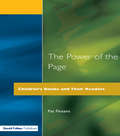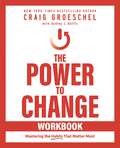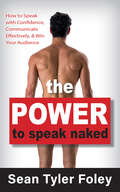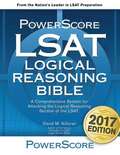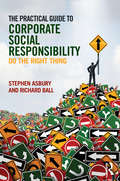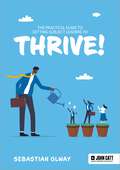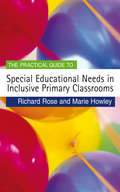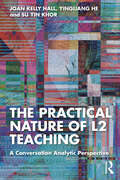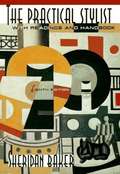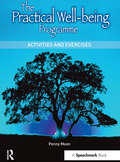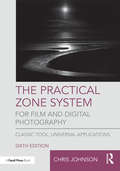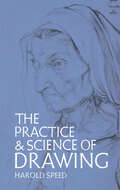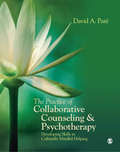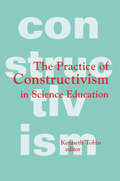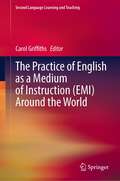- Table View
- List View
The Power of the Page: Children's Books and Their Readers
by Pat PinsentFirst Published in 1994. Routledge is an imprint of Taylor & Francis, an informa company.
The Power to Change Workbook: Mastering the Habits That Matter Most
by Craig GroeschelTime-Tested Strategies for True Transformation.Nothing is more frustrating than knowing you want to change—and need to change—but repeatedly fail to change. You've made commitments and set goals. You've resolved to do something about the issue—whether you want to lose weight, read the Bible more, overcome an addiction, or get out of debt. Yet, so far, nothing has worked, and you wonder if you're even capable of change.If this sounds like your story, then it's time to change the way you think about change.In The Power to Change pack (which includes the book and the accompanying workbook), pastor Craig Groeschel, author of Winning the War in Your Mind, blends biblical wisdom with up-to-date psychology to help you learn how to master the habits that lead to true change. In each chapter and section, you'll gain practical tools that will help you:Evaluate how you view yourself, how you view God, and the real reasons you do what you do.Discover how to master small habits that lead to big change.Employ the reap-sow principle to change the trajectory of your future.Lean on God's power—instead of your willpower—as the true cause of lasting change. The Power to Change pack offers you a clear path with practical tools, exercises, spiritual insights, and applications to help you live the life that God created you to experience. It's time to rely on a greater power source than your will and determination. It's time to actually change.This pack includes:The Power to Change book.The Power to Change Workbook.
The Power to Speak Naked: How to Speak with Confidence, Communicate Effectively, & Win Your Audience
by Sean Tyler FoleyThe Power To Speak Naked helps everyone unleash the power to speak the raw naked truth. For those who want to advance their career, increase their wage, improve their social standing, and skyrocket their confidence, The Power To Speak Naked gives them proven strategies to crush their fear of public speaking and empowers them to be able to speak in front of any audience, anywhere, at any time. The Power To Speak Naked features techniques that will make any presentation more dynamic, fire up any team, and give anyone the confidence to overcome their fear of public speaking. Within its pages, Sean Tyler Foley presents easy-to-read tips that make it possible for anyone to deliver a presentation that is engaging, persuasive, and memorable. He also presents proven actionable steps that will help anyone advance in their career and life.
The Powers of Literacy: A Genre Approach to Teaching Writing (Routledge Library Editions: Education)
by Bill Cope Mary KalantzisLiteracy remains a contentious and polarized educational, media and political issue. What has emerged from the continuing debate is a recognition that literacy in education is allied closely with matters of language and culture, ideology and discourse, knowledge and power. Drawing perspectives variously from critical social theory and cultural studies, poststructuralism and feminisms, sociolinguistics and the ethnography of communication, social history and comparative education, the contributors begin a critical interrogation of taken-for-granted assumptions which have guided educational policy, research and practice.
The Powerscore LSAT Logical Reasoning Bible
by David M. KilloranThe PowerScore LSAT Logical Reasoning Bible is the most comprehensive book available for the Logic Reasoning section of the LSAT. This book will provide you with an advanced system for attacking any Logical Reasoning question that you may encounter on the LSAT. The concepts presented in the Logical Reasoning Bible are representative of the techniques covered in PowerScore's live courses and have been consistently proven effective for thousands of our students. The book features and explains a detailed methodology for attacking all aspects of Logic Reasoning problems, including recognizing question types, identifying common reasoning elements and determining their validity, the methods for efficiently and accurately making inferences, and techniques for quickly eliminating answer choices as you solve the questions.
The Practical (and Fun) Guide to Assistive Technology in Public Schools
by Christopher R. Bugaj Sally Norton-DarrAssistive technology (AT) is a serious topic, but reading about it doesn't have to be boring! In this essential reference, authors Christopher R. Bugaj and Sally Norton-Darr throw in a few pirates, monsters, and monkeys to keep you engaged but don't sacrifice the tips, strategies, and insight that will help improve your school or district AT program. From setting up a stellar team to consultations and evaluations, and from implementation to assessing success, this guide presents detailed advice and ideas to provide AT services that effectively and efficiently help students. The nuts and bolts of each area are presented in a practical way (with amusing metaphors thrown in for good measure) so that you can directly apply what's in the book and see tangible results. Educators new to AT will find the step-by-step layout help in building an AT team and procedures, while seasoned AT professionals will find value in the fresh ideas on reducing paperwork, expanding an AT team, and strategies for considering AT for all students. Christopher R. Bugaj, an assistive technology trainer, is a founding member of the AT team for Loudoun County Public Schools in Virginia. He also works as an adjunct professor for George Mason University and is the host and producer of the award-winning podcast series A.T. TIPS cast. Sally Norton-Darr is an assistive technology trainer for Loudoun County Public Schools and a nationally certified speech-language pathologist. She presents on high- and low-tech AT topics both nationally and regionally. AUDIENCE: Administrators (K-12), assistive technology professionals, special education staff. FEATURES: Guides AT professionals through the steps of setting up a successful AT program. Information on AT, IEPs, and the law. Advice and ideas for working successfully with all stakeholders, including teachers, parents, service providers, IEP teams, and students. TECHNOLOGY: This material is suitable for any platform.
The Practical Guide to Corporate Social Responsibility: Do the Right Thing
by Stephen Asbury Richard BallCorporate social responsibility has gained substantial traction in recent decades but many still struggle with conveying the importance of integrating ethics and environmental and social values within the demands of a business world understandably concerned with making profit. First published in 2009 as ‘Do the Right Thing’, The Practical Guide to Corporate Social Responsibility guides you through the basics, teaching how to recognise CSR benefits and put principles into practice in a business-focussed way. This new edition helps readers get to grips with improving their organisation's environmental management, sustainability, health and safety and trading ethics with straightforward guidance and tips. A new ‘Do The Right Thing’ Model assists organisations with identifying risks and frames corporate social responsibility in a business context accessible to all. Features include: An updated Do the Right Thing Model aligned to the new ISO high level structure for management system standards 20 global case studies to demonstrate how the model can impact performance A corporate social responsibility policy template for your organisation’s use Helpful 'Test your thinking' exercises to check your understanding and stretch your working knowledge 100 practical actions for you to start implementing today This is an essential introduction to the complex areas of corporate social responsibility that affect health and safety practitioners, environmental managers, human resources personnel and those working with quality and business assurance. It will also be critical reading for those looking to understand how CSR fits into the new high level structure of ISO 9001, ISO 14001 and ISO 45001.
The Practical Guide to Getting Subject Leaders to THRIVE!
by Sebastian OlwayThe curriculum is the driving force for excellent teaching and learning in any school. Yet, in primary schools, the curriculum is often led by class teachers who have little or no time to give to this vital part of their role. Subject leaders have the potential to rapidly improve the way a curriculum is taught, but the challenges they face can seem insurmountable.The Practical Guide to Getting Subject Leaders to THRIVE! tackles these issues head-on with a framework rooted in educational research. Sebastian Olway's six-step THRIVE framework provides school leaders with a structure to support subject leaders and unlock their potential. The framework can also be used to guide an impactful series of professional development meetings, or to offer strategies, tips and resources for individual subject leaders.Whether you're a primary school headteacher, a senior leader, an experienced subject leader or brand new to the role, this book will help your school to THRIVE!
The Practical Guide to Getting Subject Leaders to THRIVE!
by Sebastian OlwayThe curriculum is the driving force for excellent teaching and learning in any school. Yet, in primary schools, the curriculum is often led by class teachers who have little or no time to give to this vital part of their role. Subject leaders have the potential to rapidly improve the way a curriculum is taught, but the challenges they face can seem insurmountable.The Practical Guide to Getting Subject Leaders to THRIVE! tackles these issues head-on with a framework rooted in educational research. Sebastian Olway's six-step THRIVE framework provides school leaders with a structure to support subject leaders and unlock their potential. The framework can also be used to guide an impactful series of professional development meetings, or to offer strategies, tips and resources for individual subject leaders.Whether you're a primary school headteacher, a senior leader, an experienced subject leader or brand new to the role, this book will help your school to THRIVE!
The Practical Guide to High-Leverage Practices in Special Education: The Purposeful “How” to Enhance Classroom Rigor (Evidence-Based Instruction in Special Education)
by Ruby L. Owiny Kyena CorneliusDesigned for teacher preparation programs as well as teacher professional development, The Practical Guide to High-Leverage Practices in Special Education: The Purposeful “How” to Enhance Classroom Rigor is the first book of its kind to introduce multiple HLPs working in tandem to implement evidence-based practices (EBPs).The Practical Guide to High-Leverage Practices in Special Education is a powerful tool for those dedicated to improving student outcomes. Planned with the practitioner in mind, the text’s main objective is for teachers to recognize EBPs as “what” they teach and HLPs as “how” they teach. The book is written with a focus on inclusive education, making it a valuable resource for both general and special educators.What’s included in The Practical Guide to High-Leverage Practices in Special Education: A focus on one HLP per chapter and descriptions of connected HLPs and how to use them for implementing featured EBPs Classroom scenarios for both elementary and secondary classrooms Tables of the crosswalks of connected HLPs and EBPs with resources forfurther learning The Practical Guide to High-Leverage Practices in Special Education: The Purposeful “How” to Enhance Classroom Rigor provides educators with the understanding of how HLPs and EBPs connect to effectively implement them for student success and is also an effective teaching and learning tool for teacher education preparation programs.
The Practical Guide to Primary Classroom Management (Primary Guides)
by Dr Rob Barnes`Readers of this book will want to finish it and put the techniques into practice as soon as they can!' - Youth in Mind `Seems excellent - I know I would want to use this book' - Helen Bilton, Reading University `Very relevant and appropriate for all trainees and the content would provide support for the area that the trainees are most concerned with' - Jane Warwick, University of Cambridge Classroom management is an area of genuine concern to students and NQTs. As there is only basic coverage of classroom management issues on initial training courses, new teachers often find it difficult to cope in busy classroom situations. This easy-to-read book helps you to select the right strategies for your classroom. The practical advice and points for reflection help you to think about why some strategies work and why others do not, and to decide which ones will work for you. Chapters include advice on: o behaviour management o organizing your classroom o routines, scripts and 'teacher-talk' o positive prevention through class rules and targets o praise, rewards and sanctions o teacher 'presence' o coping with difficult students.
The Practical Guide to Quality Child Care
by Pam Schiller Patricia Carter DykeThis uniquely comprehensive manual is a clear, easy-to-read handbook that provides specific guidelines for virtually every aspect of early childhood administration. Contents include: sample criteria, procedures for program development, schedules, applications, and evaluation forms. An invaluable tool for every child care facility manager. - See more at: https://www.gryphonhouse.com/books/details/the-practical-guide-to-quality-child-care#sthash.ULInNqlO.dpuf
The Practical Guide to Special Educational Needs in Inclusive Primary Classrooms (Primary Guides)
by Richard Rose Marie Howley`A well-written and thought-provoking book for teachers. It offers many ideas to improve inclusive practice in primary schools, to the benefit of all pupils, not only those with additional or different learning needs' - Special magazine Written for newly-qualified teachers and students approaching the end of their training courses, this practical and accessible text is an introduction to working with children of a range of abilities in inclusive primary classrooms. The book draws on recent research and innovation in the education of pupils with special educational needs to provide practical examples and advice on how to meet the challenges of developing effective teaching and learning in inclusive settings. Chapters cover: " becoming an inclusive teacher " pupils giving cause for concern " teaching and learning styles " creating inclusive classroom environments and teaching teams " learning from pupils " looking beyond school " developing further as a professional With advice on building positive attitudes, developing specific teaching strategies and adapting a personalising teaching approaches, the book helps teachers to build upon their earlier training in both practical and reflective ways. Richard Rose is Professor of Special and Inclusive Education and Director of the Centre for Special Needs Education and Research at University College Northampton. Marie Howley is senior lecturer in the Centre for Special Needs Education and Research at University College Northampton, teaching on both undergraduate and post graduate courses and in continuing professional development for teachers.
The Practical Nature of L2 Teaching: A Conversation Analytic Perspective
by Joan Kelly Hall Yingliang He Su Yin KhorDrawing on video recordings and transcripts from a wide range of L2 teaching contexts, The Practical Nature of L2 Teaching presents a comprehensive examination of eight sets of specialized actions and action sequences involved in whole group instruction. Each of the chapters highlights in exquisite detail the sophisticated, real-world accomplishment of L2 teaching. The purpose is not to impose a vision of how L2 teaching should be done. Instead, it is to illuminate its complexities and, in so doing, reveal informative differences between idealized understandings of L2 teaching and its lived realities. The book is essential reading for advanced undergraduates, graduate students, and researchers studying and working in the areas of classroom interaction, L2 teaching, and L2 teacher education.
The Practical Stylist with Readings and Handbook (Eighth Edition)
by Sheridan BakerThe Practical Stylist provides organizational techniques to students create sound essays, while the expository modes such as description, narration, and exposition are presented as strategies for supporting a thesis. Numerous essay models are provided to illustrate the principles of organization and explore the dynamics of language. A research paper chapter discusses online sources and the computerized library, and a brief handbook section provides help with grammar issues.
The Practical Well-Being Programme: Activities and Exercises
by Penelope MoonThis book is intended for all those interested in well being and a holistic approach whether it is in schools colleges, social settings, family support or business. The development of the programmes came out of work in Liverpool supporting families of children with severe emotional and behavioural difficulties. This book introduces readers to the underlying principles and approaches associated with a holistic approach to well-being in educational and other social contexts. Originally a specialised 'within schools' programme of therapeutic support for pupils experiencing social, behavioural and /or emotional difficulties. Based on the concept of 'holism' in its fullest sense, it utilises both traditional and complementary approaches in support of the whole person - mind, emotions, body and spirit, in the context of their whole life, incorporating support for the individual, the family, school staff within the environment and where applicable, the wider community. Each chapter consists of two main parts: information and background; activities that may be used by the teacher as well as in the classroom. The exercises at the end of each chapter are developmental in nature and divided into: Reflective Journal - encourage reflective practises and the development of emotional and spiritual intelligence by recording feeling as well as thoughts and actions; wordsmith - to encourage the development of interest in words, playing with words and defining their terms, interpreting meaning and investigating their source, etc; Activities - Knowledge tree - using the internet to develop their own knowledge tree and allow imagination to develop; activities for the classroom - fun ideas that reflect the key points of each chapter; and Things to do - ideas to develop outside the classroom, places to go, etc. The book also includes Guided Visualisation- learning through the use of 'altered states' and relaxation exercises. These include a series of guided visualisations which include physical, emotional, intellectual and creative practices. It covers A5 paperback+ CD, 162 pages.
The Practical Zone System for Film and Digital Photography: Classic Tool, Universal Applications
by Chris JohnsonThis sixth edition of The Practical Zone System by Chris Johnson updates the classic manual on Ansel Adams's landmark technique for the digital age. For photographers working digitally or with film, in color or black and white, in the studio or on the go, this simple visual language helps to control contrast and, through a process called Previsualization, provides photographers with the power of free creative expression. This new edition discusses recent advances in technology and potentials for their use in zone photography, including HDR, smartphone cameras that shoot in raw format and smartphone light meters. Johnson demonstrates how the Zone System is a universal visual and conceptual language that dramatically simplifies the problem of creating and rendering complex lighting setups.
The Practice and Science of Drawing: With 93 Illustrations And Diagrams... - Primary Source Edition (Dover Art Instruction)
by Harold SpeedMuch of the learning to practice as well as to appreciate art is concerned with understanding the basic principles. One of these principles is what Harold Speed calls "dither," the freedom that allows realism and the artistic vision to play against each other. Very important to any artist or work of art, this quality separates the scientifically accurate from the artistically accurate. Speed's approach to this problem is now considered a classic, one of the few books from the early years of this century that has continued to be read and recommended by those in the graphic arts.In this work, Harold Speed approaches this dynamic aspect of drawing and painting from many different points of view. He plays the historical against the scientific, theory against precise artistic definition. He begins with a study of line drawing and mass drawing, the two basic approaches the artist needs to learn. Further sections carry the artistic vision through unity and variety of line and mass, balance, proportion, portrait drawing, the visual memory, materials, and procedures. Throughout, Speed combines historical backgrounds, dynamic aspects which each technique brings to a work of art, and specific exercises through which the young draughtsman may begin his training. Although not a technique book in the strict sense of the terms, The Practice and Science of Drawing brings to the beginner a clear statement of the principles that he will have to develop and their importance in creating a work of art. Ninety-three plates and diagrams, masterfully selected, reinforce Speed's always clear presentation.Harold Speed, master of the art of drawing and brilliant teacher, has long been cited for this important work. For the beginner, Speed will develop a sense for the many different aspects which go into an artistic education. For the person who enjoys looking at drawings and paintings, Speed will aid developing the ability to see a work of art as the artist meant it to be seen.
The Practice of Art: A Classic Victorian Treatise
by J. D. HardingOriginally published in 1845 as The Principles & Practice of Art: With Illustrations Drawn and Engraved by the Author, this enduring guide is the work of an English painter and lithographer. J. D. Harding wrote several popular books on art instruction, and this volume constitutes one of his finest. A comprehensive manual geared toward practicing artists, the book features 24 black-and-white plates of illustrations by Harding that elucidate his observations and instructions. Topics include:• Imitation as Applied to Art • The Distinction Between the Judgment and the Feelings with Respect to Art• Beauty and Form • Composition • Light and Shade • Color• Drawing from Nature Art historians and students—especially those of nineteenth–century art—will prize this book for its philosophical theory of beauty and its abundant supply of illustrative examples, rendered in various styles of engraving and lithography.
The Practice of Authentic PLCs: A Guide to Effective Teacher Teams
by Daniel R. VenablesDiscover the keys to building effective PLCs Creating an authentic professional learning community requires breaking down the walls of isolation and collaborating to improve student learning, because collectively we are more than the sum of our parts. Grounded in the award-winning author’s foundational work with the Coalition of Essential Schools, this book enables educators to hit the ground running with a research-based process that includes: Setting the foundation for collaboration and team building Facilitating protocols Examining student and teacher work Implementing teacher-designed common formative assessments Analyzing and responding to data
The Practice of Child Therapy
by Randall I. AtlasConsistent with previous editions, this book assembles in a single volume summaries of the treatment literature and treatment procedures of the most common childhood behavior disorders facing persons who practice in applied settings clinics, schools, counseling centers, psychiatric hospitals, and residential treatment centers.Its 16 chapters cover
The Practice of Clinical and Counselling Supervision: Australian and International Applications
by Nadine Pelling Philip ArmstrongQuality supervision assists in quality service provision. The Practice of Clinical and Counselling Supervision: Australian and International Applications is the third edition of the leading Australian state-of-the-art text for supervision training applicable to a vast range of applied therapists. Counsellors, psychologists, psychotherapists, social workers, and clinical nurse supervisors will all find the presentation of supervision approaches, methods, and applications helpful.From introductory conceptualisations of counselling to ethical applications, and from interacting with suicidality to addressing supervisee fears, this book has what supervisors need to know about supervision. Specialty areas including domestic violence, Christian counselling, and the status of supervision research are also covered. This third edition uniquely details information on supervision and counselling in various countries, and thus honours the diversity of applied supervision globally. With an impressive list of contributors from Australia and the broader region, this book provides a wealth of practical information, advice, theory, research evidence, and essential training for supervisors.
The Practice of Collaborative Counseling and Psychotherapy: Developing Skills in Culturally Mindful Helping
by Dr David A. PareThe Practice of Collaborative Counseling and Psychotherapy: Developing Skills in Culturally Mindful Helping is a comprehensive introduction to counseling and psychotherapy skills designed to teach future practitioners how to develop and foster collaborative relationships with their clients. Keeping power relations and cultural diversity at the forefront, Paré's text examines, step by step, the skills involved in collaborative therapeutic conversation--an approach that encourages a contextual view of clients and counteracts longstanding traditions of focusing primarily on individual pathology. Indeed, this insightful text teaches students how to keep clients at the heart of their therapy treatment by actively engaging them in the helping process.
The Practice of Constructivism in Science Education
by Kenneth TobinThis volume provides a needed elaboration of theories and potential applications of constructivism in science education. Although the term "constructivism" is used widely, there has been a dearth of materials to guide science educators concerning the potential of constructivism to influence what is done in the field. In fact, there has been a tendency for constructivism to be viewed as a method that can be used in a classroom. This view tends to diminish the power of constructivism as a way of thinking about education, and in particular, about science education. The chapters in this book address the need to document the theoretical roots of constructivism and to describe how practitioners have applied constructivist oriented beliefs in the practice of K-12 teaching of science and mathematics, as well as teacher education. Not only does this book contain different theoretical perspectives on constructivism, but it also features a chapter that critiques constructivism as an epistemology. Specific topics covered include: * cooperative learning, * the negotiation of meaning, * problem centered learning, * social construction of knowledge, * science in culturally diverse settings, * curriculum planning and implementation, and * instructional technology. Issues associated with the preparation and enhancement of science teachers and the reform of science education are also explored.
The Practice of English as a Medium of Instruction (Second Language Learning and Teaching)
by Carol GriffithsThis edited volume presents eleven empirical papers reporting the existing literature and the results of an original study focusing on EMI (English as a medium of instruction) in a particular area (Central and Eastern Europe, Western and Southern Europe, Nordic/Baltic countries, Central Asia, the Middle East, East Asia, South-East Asia, North Africa, Sub-Saharan Africa, South Asia, and Latin America). Each of these different areas tends to have its own ways of dealing with the EMI issue, and these are brought together in a meta-analysis in the final chapter. Implications for the conduct of English as a medium of instruction are drawn, both on a chapter-by-chapter basis and also in the meta-analysis. The examination of EMI on a contextual basis is a unique feature of this book, setting it apart from others in the field, which almost all deal with a single or limited context. The volume will be of interest to policymakers, institutional heads, graduate students and their teachers, and to thesis writers and researchers.
